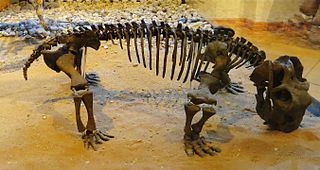
Lystrosaurus is an extinct genus of herbivorous dicynodont therapsids from the late Permian and Early Triassic epochs. It lived in what is now Antarctica, India, China, Mongolia, European Russia and South Africa. Four to six species are currently recognized, although from the 1930s to 1970s the number of species was thought to be much higher. They ranged in size from that of a small dog to 2.5 meters long.
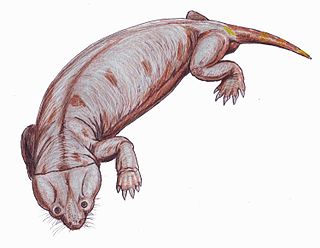
The Cistecephalus Assemblage Zone is a tetrapod assemblage zone or biozone found in the Adelaide Subgroup of the Beaufort Group, a majorly fossiliferous and geologically important geological group of the Karoo Supergroup in South Africa. This biozone has outcrops located in the Teekloof Formation north-west of Beaufort West in the Western Cape, in the upper Middleton and lower Balfour Formations respectively from Colesberg of the Northern Cape to east of Graaff-Reinet in the Eastern Cape. The Cistecephalus Assemblage Zone is one of eight biozones found in the Beaufort Group, and is considered to be Late Permian in age.
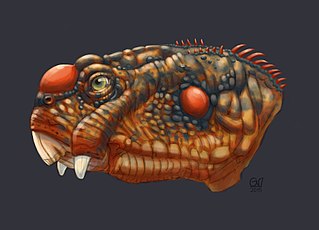
The Daptocephalus Assemblage Zone is a tetrapod assemblage zone or biozone found in the Adelaide Subgroup of the Beaufort Group, a majorly fossiliferous and geologically important geological Group of the Karoo Supergroup in South Africa. This biozone has outcrops located in the upper Teekloof Formation west of 24°E, the majority of the Balfour Formation east of 24°E, and the Normandien Formation in the north. It has numerous localities which are spread out from Colesberg in the Northern Cape, Graaff-Reniet to Mthatha in the Eastern Cape, and from Bloemfontein to Harrismith in the Free State. The Daptocephalus Assemblage Zone is one of eight biozones found in the Beaufort Group and is considered Late Permian (Lopingian) in age. Its contact with the overlying Lystrosaurus Assemblage Zone marks the Permian-Triassic boundary.

The Lystrosaurus Assemblage Zone is a tetrapod assemblage zone or biozone which correlates to the upper Adelaide and lower Tarkastad Subgroups of the Beaufort Group, a fossiliferous and geologically important geological Group of the Karoo Supergroup in South Africa. This biozone has outcrops in the south central Eastern Cape and in the southern and northeastern Free State. The Lystrosaurus Assemblage Zone is one of eight biozones found in the Beaufort Group, and is considered to be Early Triassic in age.

The Pristerognathus Assemblage Zone is a tetrapod assemblage zone or biozone which correlates to the upper Abrahamskraal Formation and lowermost Teekloof Formation, Adelaide Subgroup of the Beaufort Group, a fossiliferous and geologically important geological Group of the Karoo Supergroup in South Africa. The thickest outcrops, reaching not more than 300 metres (980 ft), occur just east of Sutherland through to Beaufort West in the south and Victoria West in the north. Exposures are also found west of Colesberg and south of Graaff-Reinet. The Pristerognathus Assemblage Zone is the third biozone of the Beaufort Group.

The Tropidostoma Assemblage Zone is a tetrapod assemblage zone or biozone which correlates to the lower Teekloof Formation, Adelaide Subgroup of the Beaufort Group, a fossiliferous and geologically important geological Group of the Karoo Supergroup in South Africa. The thickest outcrops, reaching approximately 240 metres (790 ft), occur from east of Sutherland through to Beaufort West and Victoria West, to areas south of Graaff-Reinet. Its northernmost exposures occur west/north-west of Colesberg. The Tropidostoma Assemblage Zone is the fourth biozone of the Beaufort Group.
Moschorhinus is an extinct genus of therocephalian in the family Akidnognathidae, with only one species: M. kitchingi. It was a carnivorous, lion-sized synapsid which has been found in the Late Permian to Early Triassic of the South African Karoo Supergroup. It had a broad, blunt snout which bore long, straight canines. It appears to have replaced the gorgonopsids ecologically, and hunted much like a big cat. While most abundant in the Late Permian, it survived a little after the Permian Extinction, though these Triassic individuals had stunted growth.

Theriognathus is an extinct genus of therocephalian therapsid belonging to the family Whaitsiidae, known from fossils from South Africa, Zambia, and Tanzania. Theriognathus has been dated as existing during the Late Permian. Although Theriognathus means mammal jaw, the lower jaw is actually made up of several bones as seen in modern reptiles, in contrast to mammals. Theriognathus displayed many different reptilian and mammalian characteristics. For example, Theriognathus had canine teeth like mammals, and a secondary palate, multiple bones in the mandible, and a typical reptilian jaw joint, all characteristics of reptiles. It is speculated that Theriognathus was either carnivorous or omnivorous based on its teeth, and was suited to hunting small prey in undergrowth. This synapsid adopted a sleek profile of a mammalian predator, with a narrow snout and around 1 meter long. Theriognathus is represented by 56 specimens in the fossil record.

Aelurosaurus is a small, carnivorous, extinct genus of gorgonopsian therapsids from the Mid Permian to Late Permian of South Africa. It was discovered in the Karoo Basin of South Africa, and first named by Richard Owen in 1881. It was named so because it appeared to be an ancestor for cat-like marsupials, but not yet a mammal itself. It contains five species, A. felinus, A. whaitsi, A. polyodon, A. wilmanae, and A.? watermeyeri. A. felinus, the type species, is generally well described with established features, while the other four species are not due to their poorly preserved holotypes.
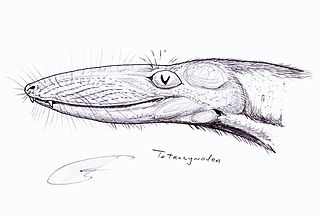
Tetracynodon is an extinct genus of therocephalian. Fossils of Tetracynodon have been found in the Karoo Basin of South Africa. Two species are known: the type species T. tenuis from the Late Permian and the species T. darti from the Early Triassic. Both species were small-bodied and probably fed on insects and small vertebrates. Although Tetracynodon is more closely related to mammals than it is to reptiles, its braincase is very primitive and shares more in common with modern amphibians and reptiles than it does with mammals.

Progalesaurus is an extinct genus of galesaurid cynodont from the early Triassic. Progalesaurus is known from a single fossil of the species Progalesaurus lootsbergensis, found in the Lystrosaurus Assemblage Zone of the Balfour Formation. Close relatives of Progalesaurus, other galesaurids, include Galesaurus and Cynosaurus. Galesaurids appeared just before the Permian-Triassic extinction event, and disappeared from the fossil record in the Middle-Triassic.
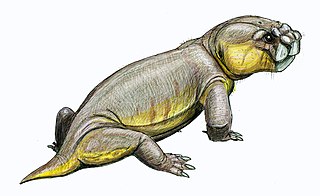
Pelanomodon is an extinct genus of dicynodont therapsids that lived in the Late Permian period. Fossil evidence of this genus is principally found in the Karoo Basin of South Africa, in the Dicynodon Assemblage Zone. Lack of fossil record after the Late Permian epoch suggests that Pelanomodon fell victim to the Permian-Triassic extinction event.

Tropidostoma is a medium-sized herbivorous oudenodontid dicynodont therapsid that lived during the Late Permian (Lopingian) period in South Africa. The first Tropidostoma fossil was described by Harry Govier Seeley in 1889. Later two subspecies were identified. Tropidostoma fossils are an index fossil in a biozone of the Karoo Basin known as the Tropidostoma Assemblage Zone. This biozone is characterized by the presence of this species in association with another dicynodont species, Endothiodon uniseries.
Olivierosuchus is an extinct genus of therocephalian therapsids. It is a member of the family Akidnognathidae. Fossils of Olivierosuchus have been found from the Early Triassic Lystrosaurus Assemblage Zone in South Africa. Unlike other akidnognathids such as Moschorhinus, it has a narrow snout and fewer postcanine teeth. As a distinguishing feature, Olivierosuchus also has a sharp ridge near the choana, an opening in the skull palate. Bumps and projections cover the pterygoid, a bone that forms part of the palate.

The Abrahamskraal Formation is a geological formation and is found in numerous localities in the Northern Cape, Western Cape, and the Eastern Cape of South Africa. It is the lowermost formation of the Adelaide Subgroup of the Beaufort Group, a major geological group that forms part of the greater Karoo Supergroup. It represents the first fully terrestrial geological deposits of the Karoo Basin. Outcrops of the Abrahamskraal Formation are found from the small town Middelpos in its westernmost localities, then around Sutherland, the Moordenaarskaroo north of Laingsburg, Williston, Fraserburg, Leeu-Gamka, Loxton, and Victoria West in the Western Cape and Northern Cape. In the Eastern Cape outcrops are known from Rietbron, north of Klipplaat and Grahamstown, and also southwest of East London.
Pelictosuchus is an extinct genus of therocephalian therapsids from the Late Permian of South Africa. It is classified in the family Akidnognathidae. The type species Pelictosuchus paucidens was named by South African paleontologist Robert Broom in 1940 from the Dicynodon Assemblage Zone.

The Capitanian extinction event was an extinction event that occurred around 260 million years ago during a period of decreased species richness and increased extinction rates in the late Middle Permian during the Guadalupian epoch. It is also known as the end-Guadalupian extinction event because of its initial recognition between the Guadalupian and Lopingian series; however, more refined stratigraphic study suggests that extinction peaks in many taxonomic groups occurred within the Guadalupian, in the latter half of the Capitanian age.

The Balfour Formation is a geological formation that is found in the Beaufort Group, a major geological group that forms part of the greater Karoo Supergroup in South Africa. The Balfour Formation is the uppermost formation of the Adelaide Subgroup which contains all the Late Permian-aged biozones of the Beaufort Group. Outcrops and exposures of the Balfour Formation are found from east of 24 degrees in the highest mountainous escarpments between Beaufort West and Fraserburg, but most notably in the Winterberg and Sneeuberg mountain ranges near Cradock, the Baviaanskloof river valley, Graaff-Reniet and Nieu Bethesda in the Eastern Cape, and in the southern Free State province.

The Katberg Formation is a geological formation that is found in the Beaufort Group, a major geological group that forms part of the greater Karoo Supergroup in South Africa. The Katberg Formation is the lowermost geological formation of the Tarkastad Subgroup which contains the Lower to Middle Triassic-aged rocks of the Beaufort Group. Outcrops and exposures of the Katberg Formation are found east of 24 degrees on wards and north of Graaff-Reniet, Nieu Bethesda, Cradock, Fort Beaufort, Queensdown, and East London in the south, and ranges as far north as Harrismith in deposits that form a ring around the Drakensberg mountain ranges.

Thliptosaurus is an extinct genus of small kingoriid dicynodont from the latest Permian period of the Karoo Basin in KwaZulu-Natal, South Africa. It contains the type and only known species T. imperforatus. Thliptosaurus is from the upper Daptocephalus Assemblage Zone, making it one of the youngest Permian dicynodonts known, living just prior to the Permian mass extinction. It also represents one of the few small bodied dicynodonts to exist at this time, when most other dicynodonts had large body sizes and many small dicynodonts had gone extinct. The unexpected discovery of Thliptosaurus in a region of the Karoo outside of the historically sampled localities suggests that it may have been part of an endemic local fauna not found in these historic sites. Such under-sampled localities may contain 'hidden diversities' of Permian faunas that are unknown from traditional samples. Thliptosaurus is also unusual for dicynodonts as it lacks a pineal foramen, suggesting that it played a much less important role in thermoregulation than it did for other dicynodonts.




















